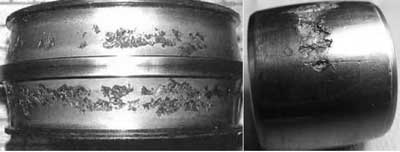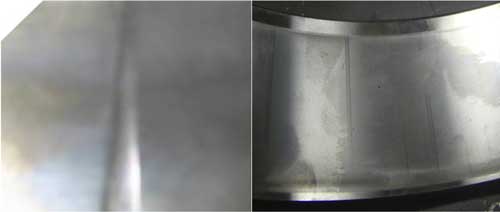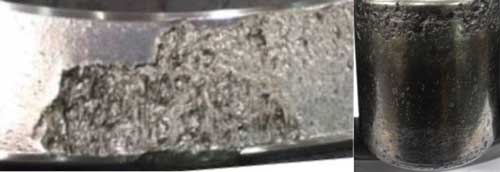MenuClose
FATIGUE

Failure from fatigue is normally caused by repeated stresses developed in the contacts between the rolling elements and the raceways and is visible as flaking of particles from the surface.
MISALIGNMENT

Misalignment often results in overheating. Whether it is shaft, housing, or component misalignment it causes conditions where the shaft is not aligned with the housing resulting in an irregular overload of the rolling elements.
FRETTING CORROSION

Fretting corrosion occurs when there is relative movement either between the bearing and housing or bearing and shaft. The appearance will be of rust or brownish black color. Inconsistencies in form provide the opportunity for fretting corrosion.
FRACTURE

Fracturing, cracking or chipping results when stress concentrations exceed the tensile strength of the material and is typically revealed from excessive axial impact loading or overstressing.
OVER LOADING

Overload is an operation or operating conditions that exceed the design limits, bearing speed or temperature requirements.
FLUTING

Electric current passes through a bearing, arcing occurs at the point between the races and the rolling element. This creates a burning effect and when the electricity is in large charges, there is severe burn marks or mini-volcanoes formed on the raceway and/or rollers thus creating fluting or wash boarding on components as the current passes through the bearing.
BRINELLING

Brinelling is a depression of the raceway and/or rolling element. True brinelling will leave the original surface texture in the depression. False brinelling wears away the surface texture. It takes a microscope to determine if the issue is false or true brinelling.
ACID ETCHING

Acid etching occurs when moisture enters the bearing and mixes with the lubricant. The sulfur in the lubricant mixes with the water and creates a sulfuric acid yielding a surface raceway with a blackish pattern. If the bearing is stationary and moisture enters the bearing, a more significant pattern will be present and will be similar to the roller spacing.
EDGE LOADING

Edge loading normally occurs when the bearing is too heavily loaded and/or when the profile of either the roller or the raceway is insufficient. Spalling or flaking will begin at the edge of the raceway or rolling element and propagate across the rolling path normally in the load zone area.
LUBRICATION

Inadequate lubrication will present as a frosty gray appearance on the races and rolling elements. As this progresses, the frosty area will have a smooth feel in one direction and a well-defined roughness in the other. This will eventually lead to flaking or spalling which is referred to as fine grain spalling and bearing failure. Insufficient lubrication will often present at the roller ends where the sliding friction of roller to flange is first to break down.
INSTALLATION
Many bearing failures are inadvertently initiated at installation. Dropped parts, contamination, forceful installation along with less than ideal housings and components are issues. Having a clean work area, proper tools and clear procedures along with proper lubrication will improve overall bearing performance.
 Download PDF
Download PDF